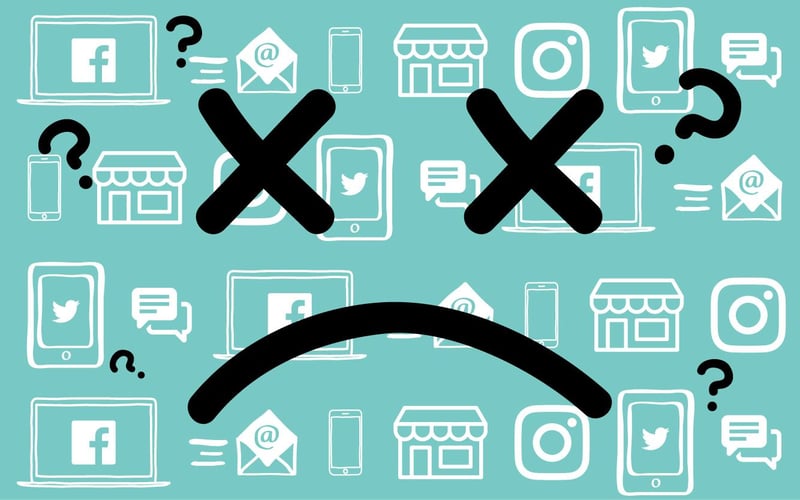Brand Consistency: How to wield it in online retail?

Keep the good stuff coming
Subscribe to our blog newsletter and get monthly content that helps you manage product data smarter.
No spam. Just real value.
Facebook, Twitter, Instagram, Pinterest, Snapchat. Print ads, landing pages, email newsletters. Video, mobile apps, SMS. Today, your business has more marketing channels at its disposal than ever before. A bewildering and exciting thing to wrap your head around. While having so many channels at your disposal can make it easier to make a branding mistake, it also provides a huge opportunity to reach customers far and wide with an effective brand strategy.
But that doesn’t mean every online business is nailing it.
To make sure your business is fully wielding its power to enforce brand consistency across all those channels, it’s important to understand exactly what brand consistency is and why it’s important.
We’ll also talk about the tools and strategies you can use to enforce consistency within your own brand, meaning your customers will always recognize your brand, no matter where they see it.
What is Brand Consistency?
Brand Consistency is the ability to deliver a cohesive messaging and design match across all platforms over time. The messaging and design elements should be in line with your branding themes like your values, your voice, and your mission.
Every good brand has a personality that they need to transmit, and like all good personalities, it is better if they don't change at the drop of the hat.
Brand Consistency makes your company likeable and trustworthy, an absolute must in the age of online retail.
Why Does Brand Consistency Matter?
Let’s pause on the reading for a minute and hit play on the video below.
From the minute that commercial hits their TV screen, most consumers will be able to identify it’s for Target. There’s no logo. No voice over saying the name of the company. But the upbeat music; the bright, open backgrounds; the models in fresh, trendy outfits dancing and making frequent eye contact with the camera—those are all very recognizable parts of Target’s brand that it uses in all its advertisements. It’s 41 seconds before the word “Target” appears on screen, and 48 seconds before the Target logo makes an appearance. But consumers are already thinking about Target before either of those things happen because the branding in this ad is just so recognizable.
Target is consistent, which means consumers recognize its brand instantly without a lot of prompting.
That’s the power of brand consistency. It makes your business so recognizable that consumers begin to think about it the moment they encounter your marketing—without being explicitly told what the company is and without being asked to make a purchase.
To understand why it’s important to enforce brand consistency, think about how you felt when you watched that Target ad. You might have shimmied your shoulders a little bit along with the upbeat song that was playing. You were probably thinking about shopping at Target and how that feels. Maybe you were even thinking about what you’ll buy on your next trip to Target, even if you weren’t doing so consciously.
Not only is Target consistent in how it presents itself in ads. The experience in each store is consistent. The layout, the smells, the feeling, the design. It's all meant to form part of the brand identity. When you go online, the feeling remains the same.
Brand consistency on that level makes brands feel more dependable and trustworthy. It encourages customers to feel some kind of way—happy and dancey, in Target’s case.
More importantly, brand consistency plays into the long-understood concept that buying a product is often more of an emotional decision than a practical one. When you make your customers feel like they know, depend on, and trust your brand, they’re feeling all the right emotions to happily hit the “check out” button.
What Makes Brand Consistency On This Level So Hard?
It's simply not easy to be consistent, and consistently creative, on all the available channels.
Customers who engage with brands online are looking for perfectly seamless transitions between different platforms and technology (like when they move from a laptop to a smartphone). This creates technology and compatibility issues that weren’t there a decade ago.

Then there’s all the complexity that comes with the advent of social media. Brand consistency on social channels can be tricky, because from Facebook to Twitter and Instagram to Snapchat, every social media platform has its own best practices—what works really well on one platform may completely tank on another.
For online retailers, it is also a game of which shopping ads and platforms to choose to sell on. Do you want to integrate with social selling? Do you want to use influencers and affiliates? Do you want to set up a retail network or bang on the big marketplaces?
Wasn’t technology supposed to make our lives easier? When it comes to maintaining brand consistency, it seems to have just made everything a lot more complicated.
Luckily, your company does have the tools, skills, and power to nail its brand strategy.
Here’s how:
4 Ways to Nail Brand Consistency Across All Channels
Want to be more like Target, Dove, Dollar Shave Club, and other brands that have a consistent, recognizable voice across all their channels? Here’s what you need to do.
Have a Plan
Here’s everything that goes into creating brand consistency on the same level as the brands that are nailing it:
- Your mission statement, which should help guide everything your business does, including marketing.
- Your product, including your unique selling points, product descriptions, and what sets you apart from your competitors.
- Your audience, what they want in a product like yours, and what they value.
- Your style guide, which includes your logo, color scheme, typeface and other standards that help keep your brand’s visuals consistent across all marketing channels.
- Your messaging, which might be the most important part of brand consistency. This is where customers will start to form impressions about your brand and your products that will lead them to recognize your branding when they encounter it later. Messaging affects how your products are perceived and what emotions customers feel about your brand when they see your marketing.
When it comes to nailing brand consistency, the most important thing you can do is have a set of corporate guidelines that outline every single aspect of your brand strategy.
That means having one central, accessible document or wiki where you keep guidelines for your logo, tagline, typography, mascot, color scheme, and messaging.
Every employee who creates visual or written communication for your brand needs to treat this document like a checklist so everyone is using the same standards for all brand messaging across all channels.
Aim for Quality, Not Quantity
Choose a small set of channels to win on.
Yes, it is super tempting to be on all available channels. And sure, it’s better for a brand to be accessible to its customers on all the social media platforms those customers use. But it’s better to have a really memorable presence on one or two platforms than to be mediocre on all of them.
There are so many marketing channels to choose from, your brand won’t be able to utilize them all. Build it into your brand strategy to have a strong, consistent, high-quality presence on certain channels, and build in more as you’re able to after you’ve mastered the first few.
For example, you can use different channels for different goals. Maybe you want to use Linkedin for employer branding, Instagram for showcasing products, and your online store and Amazon for selling. That's only 4 channels you need to master.
To choose the best channels, think about the following:
- Where do your customers hang out the most?
- Which channels will help you showcase your product in the best way?
- Which channels match your messaging and style?
- Which channels offer you the best means to share your content?
- Where do you already have a following or customer base?
If you need help figuring out which channels to concentrate on for the best results, ecommerce metrics are the place to start. Check out our article on the 15 most important ecommerce metrics and how to measure each (with equations included!).
Have an Approval Process
The best way to avoid a brand consistency oops is to put brand messaging in front of as many (authoritative) eyes as possible before it goes out into the world. That way, if there are any inconsistencies, someone is likely to catch and correct them before they reach any customers.
Build a marketing approval process that ensures one or a small group of employees who really get your company’s brand have the final say on any messaging before it goes live.
This can be as simple as assigning someone to write, someone to edit, and someone to publish. That way it passes through at least 3 people before it is seen by your customers.
Be Authentic
The easiest way to maintain brand consistency is to be true to yourself and your company with your brand messaging. That way, enforcing brand consistency will be natural, not a chore.
This step will make all the others easy to tackle. If you are true to yourself, you'll know which channel works best for you.
Wendy's sassiness is best for Twitter.
Tesla's exclusivity means they only allow you to buy on their own website and in Tesla showrooms.
Lego kills it on YouTube because their product is naturally made for play.
Where does your brand fit, if you really are honest with yourself?
Now that you know why brand consistency is so important—and how to wield your power to enforce consistency across all of your marketing channels—it’s time to put together a plan to make your brand as consistently recognizable as possible. Your customers will love it—and so will your bottom line.

What if your product data actually worked for you?
We’ll show you how Plytix helps you stop fixing data—and start using it.
Related posts
Keep the good stuff coming
Subscribe to our blog newsletter and get monthly content that helps you manage product data smarter.
No spam. Just real value.





Think others should see this?
Go ahead and share it.